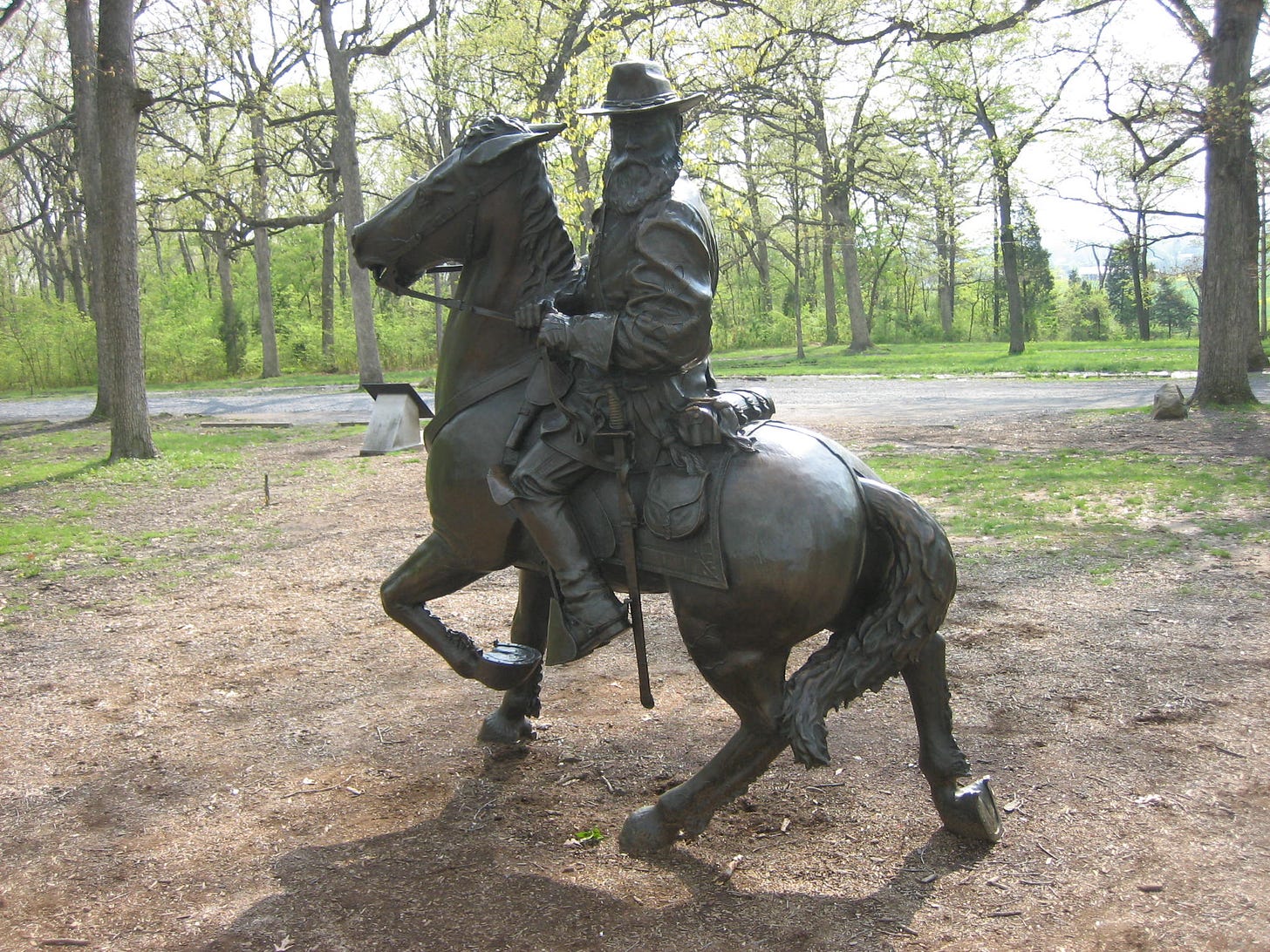
In 1998 a monument honoring Confedeate general James Longstreet was unveiled on the Gettysburg battlefield.
From the beginning, arguments defending the removal or relocation of Confederate monuments have largely focused on a coalition of “anti-Southerners” who supposedly are hell bent on ‘canceling’ or ‘erasing’ all public reminders of the Confederacy. The ultimate goal, they argue, is to erase entirely the history of the Confederacy from public memory.
It’s a tired argument that almost always fails to acknowledge the difference between history and memory. The belief that removing a monument or some other commemorative artifact constitutes an erasing of history assumes that we have no other access to the past, namely through books and other resources. It also assumes that we are incapable of studying a certain aspect of the past without the presence of a commemorative object, such as a monument. This is absurd.
More importantly, these arguments, pointing to an organized community devoted to wiping the public landscape clean of Confederate monuments, assumes that the individuals and organizations originally responsible for them enjoyed some sort of priviledged access to the past and that the values that they hoped to memorialize ought to be accepted and embraced forever.
What we fail to acknowledge, however, is that the individuals and organizations responsible for our nation’s Confederate monument landscape engaged in their own version of ‘cancel culture.’ Confederate veterans, the United Daughters of the Confederacy, and other organizations made their own decisions as to who would be remembered and who would hopefully be forgotten.
I’ve been reminded of this as I make my way through Elizabeth Varon’s new biography of James Longstreet, which pays special attention to his postwar career. There is a reason why there are no monuments honoring Robert E. Lee’s “Old War Horse” before 1998. Longstreet was considered a traitor in the postwar South’s burgeoning Lost Cause memory of the war for accepting a federal appointment in the Grant administration, command of Louisiana’s bi-racial state militia, and for his embrace of the Radical Republican agenda.
W. Todd Groce, President & CEO of the Georgia Historical Society, concisely explains why Longstreet is not honored in his home state:
Longstreet is as an example of how the art on the Capitol grounds in Atlanta reflects the South of the 1900s, not the 1860s. The only Confederate general whose statue is there is John B. Gordon. There isn’t one for James Longstreet, who in effect was “canceled”—not from history, because statues neither write nor erase history. But they do shape public memory. Longstreet, the greatest Georgian who fought in the Civil War, Robert E. Lee’s “Old War Horse,” was the worst Georgian of the postwar era in the judgment of the Lost Cause revisionists who wrote the public narrative that shaped how those of us born in the 20th century would remember the conflict. Based on his military record in 1865, it’s Longstreet whose statue should be at the Capitol. Instead, it’s Gordon, whose postwar political record (in contrast to Longstreet’s) and self-promotion transformed him, in the eyes of many, into the living embodiment of the Confederacy.
Longstreet was not only absent from public spaces. His likeness was also absent from numerous prints of Lee and his generals that were sold throughout the postwar years. The authors of The Confederate Image describe Longstreet’s absence as having been consigned to “iconographic oblivion.”
Lost Cause writers like Jubal Early and others made a conscious effort to weed out former Confederates that they viewed as having turned their back on the Confederacy.
There is a reason why there are no monuments honoring Southern Unionists dating to the high point of Confederate monument dedications at the beginning of the twentieth century.
There is a reason why the UDC never got around to dedicating a monument honoring the thousands of Black Southerners who fought for their freedom and the end of slavery in the United States army. This history directly threatened their preferred understanding of African Americans as compliant and loyal to their masters and the Confederacy. This is the image and message that graces Confederate monuments in places like Arlington National Cemetery.
This erasure of this past was not accidental but intentional and intended to stand the test of time.
The UDC and others succeeded in shaping the commemorative landscape, not because their preferred memory of the Civil War and the Confederacy was historically accurate, but because they had the political power to do so.
Their world view was embraced by a significant percentage of the white population and protected through a legal framework and violence of the Jim Crow era, which prevented anyone from challenging it through elected office or through the vote.
That protection thankfully no longer exists. The removal of Confederate monuments over the past few years is the direct result of a gradual shift in political power and the addition of voices and perspectives that have long been excluded from matters of public policy, including how the past is commemorated in public spaces.
We can disagree over whether Confederate monuments should be removed, but the hundreds of monuments that no longer dominate our public spaces reflects a process of memory that is no different from that which initially shaped the commemorative landscape by the early twentieth century.
Our collective memory is constantly evolving and the need to recall our collective past is deeply embedded in the human experience.
It is my hope that rather than view the removal of monuments as simply an ‘erasure’ of the past, we embrace it as an opportunity to remember and celebrate aspects of the past that were intentionally ‘canceled’ long ago.
And this time, perhaps we can uncover individuals and stories from our collective past that represent and highlight the values that all of us claim to uphold.
Longstreet eventually got his monument. Unfortunately, it looks like a cross between a gnome and Tom Berenger, who played Longstreet in the movie Gettysburg. Oh well.
















Just to be clear, I am not suggesting that James Longstreet deserves a statue. Mr. Groce is not suggesting such a thing either. What we are pointing out is that memory is constantly evolving and fluid. What we are now witnessing is a natural extension of public memory.
I concur (except I like the Longstreet statue!).